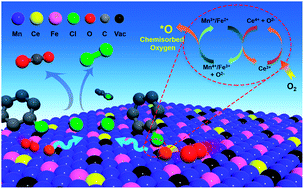Ce–Fe–Mn catalysts were prepared by an oxalic acid assisted co-precipitation method. The influence of Ce doping and calcination temperature on the catalytic oxidation of chlorobenzene (as a model VOC molecule) was investigated in a fixed bed reactor. The Mn3O4 phase was formed in Ce–Fe–Mn catalysts at low calcination temperatures (<400 °C), which introduced more chemisorbed oxygen, and enhanced the mobility of O atoms, resulting in an improvement of the reduction active of Mn3O4 and Fe2O3. Additionally, CeO2 has strong redox properties, and Ce4+ would oxidize Mnx+ and Fex+. Therefore, the interaction of Ce, Fe and Mn can improve the content of surface chemisorbed oxygen. As compared with Fe–Mn catalysts, the catalytic conversion of chlorobenzene over Ce(5%)–Fe–Mn-400 was about 99% at 250 °C, owing to high specific surface area, Mn3O4 phase, and Ce doping. However, with the increase in roasting temperature, the performance of the catalysts for the catalytic combustion of chlorobenzene was decreased, which probably accounts for the formation of the Mn2O3 phase in Ce–Fe–Mn-500 catalysts, leading to a decrease in the specific surface area and concentration of chemically adsorbed oxygen. As a result, it can be expected that the Ce–Fe–Mn catalysts are effective and promising catalysts for chlorobenzene destruction.

